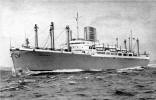|
 The SS Panama was built in 1939 with a length of 493 1/2 feet, she had a beam (width) of 64 feet and a draft of 26 feet, 3 inches. In her original configuration her holds carried 76,251 cubic feet of cargo. When refitted as a troop ship the Parker had space for 2,324 persons. Driven by twin turbine engines the
Parker could make no more than 18 knots in a fair sea. The SS Panama was built in 1939 with a length of 493 1/2 feet, she had a beam (width) of 64 feet and a draft of 26 feet, 3 inches. In her original configuration her holds carried 76,251 cubic feet of cargo. When refitted as a troop ship the Parker had space for 2,324 persons. Driven by twin turbine engines the
Parker could make no more than 18 knots in a fair sea.
In her first state of life as the USS Panama, the ship frequented the Caribbean and of ten called at Cristobal in the Canal Zone during the first part of the war. Later, she was on the Atlantic run as far as South Africa and then operated between the US and the Atlantic Theater of War. ten called at Cristobal in the Canal Zone during the first part of the war. Later, she was on the Atlantic run as far as South Africa and then operated between the US and the Atlantic Theater of War.
The Panama was transferred to the Army from the Panama Railroad Co on June 13, 1941. Despite her inauspicious beginning on Friday the 13th, the Army operated the
Panama as a cargo ship for the next two months.
 In August she was converted to a troop ship. Conversion involved gutting spaces such as In August she was converted to a troop ship. Conversion involved gutting spaces such as bars and lounges and individual staterooms to use as much space as possible for multi-tiered bunks. Deck space was given a new image as small cannon (a 4-inch gun is shown being hoisted in place here) were bolted or welded into place. Protective shields of steel plate created a gun emplacement. While not technically a war ship, the Parker had the ability to talk back if a German U-boat were to be spotted. Fortunately, the Navy Armed Guard never had to fire their deck guns in anger and after twelve days at sea the Parker docked in Belfast, Ireland on January 9th, l944. bars and lounges and individual staterooms to use as much space as possible for multi-tiered bunks. Deck space was given a new image as small cannon (a 4-inch gun is shown being hoisted in place here) were bolted or welded into place. Protective shields of steel plate created a gun emplacement. While not technically a war ship, the Parker had the ability to talk back if a German U-boat were to be spotted. Fortunately, the Navy Armed Guard never had to fire their deck guns in anger and after twelve days at sea the Parker docked in Belfast, Ireland on January 9th, l944.
 The Army was not the only branch of service quartered on the ship. Merchant Marine seamen were charged with operating the ship, Also on board were members of the US Navy Armed Guard. A largely unknown group, they, ensured the safety of similar ships at sea. The Army was not the only branch of service quartered on the ship. Merchant Marine seamen were charged with operating the ship, Also on board were members of the US Navy Armed Guard. A largely unknown group, they, ensured the safety of similar ships at sea.
When the metamorphosis was completed she was renamed the JAMES PARKER in honor of Brigadier General James Parker, Class of 1876, USMA.
After the war had ended the vessel was converted a second time and was used to transport war-brides and babies. On one voyage, the Panama also brought back $80 million worth of paintings that the Germans had looted from various European capitals. Space was made for the art works in the air-conditioned dining room, and later they were delivered to the National Art Gallery in Washington, D.C.
The ship was ultimately returned to it's owners and suffered the ignominy of a shaky rebirth. Now again named the Panama, it's first post-war sailing out of NY was scheduled for September 20, 1946. Half an hour before sailing time, a maritime strike was called and the Panama was forced to remain tied at her pier. Rather than sail the high sea, the passengers lived aboard the ship courtesy of the Panama Line for the next two weeks..
|





